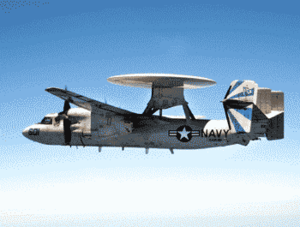E-2 Hawkeye
|
|
| E-2 Hawkeye | ||
|---|---|---|
 | ||
| Description | ||
| Role | Airborne early warning, command and control | |
| Crew | 5 (2 pilots, 3 naval flight officers - combat information center officer, air control officer, radar operator) | |
| Dimensions | ||
| Length | 57 ft 7 in | 17.56 m |
| Wingspan | 80 ft 7 in | 24.58 m |
| Height | 18 ft 4 in | 5.58 m |
| Wing area | 700 ft² | 65 m² |
| Weights | ||
| Empty | 37,678 lb | 17,090 kg |
| Loaded | ||
| Maximum take-off | 51,569 lb | 23,391 kg |
| Powerplant | ||
| Engines | 2 Allison T56-A-425 or -427 turboprops | |
| Power | ||
| Performance | ||
| Maximum speed | 375 mph | 604 km/h |
| Ferry range | 1,605 mi | 2,583 km |
| Service ceiling | 30,800 ft | 9,88 m |
| Rate of climb | 2,515 ft/min | 767 m/min |
The Grumman E-2 Hawkeye is the United States Navy's all-weather, aircraft carrier-based tactical warning and control system aircraft.
The Hawkeye provides all-weather airborne early warning and command and control functions for the carrier battle group. Additional missions include surface surveillance coordination, strike and interceptor control, search and rescue guidance and communications relay. An integral component of the carrier air wing, the E-2C uses computerized sensors to provide early warning, threat analyses and control of counteraction against air and surface targets. It is a high-wing aircraft with stacked antennae elements contained in a 24 foot (7.3 m) rotating dome above the fuselage. The peculiar airflow over and around the radar dome led to a multiple-surface tail unit.
The continuous improvements in early airborne radars by 1956 led to the concept of an airborne early warning and command and control aircraft. The first aircraft to perform this mission was the Grumman E-1 Tracer (a variant of the S-2 Tracker anti-submarine aircraft), which saw service from 1954 to 1964. The E-1's successor, the E-2 Hawkeye, was the first carrier-based aircraft designed from the outset for the all-weather airborne early warning and command and control function. Since replacing the E-1 in 1964, the Hawkeye has been the "eyes of the fleet." Since its combat debut during the Vietnam conflict, the E-2 has served the Navy around the world. Hawkeyes directed F-14 Tomcat fighters flying combat air patrol during the two-carrier battle group joint strike against terrorist-related Libyan targets in 1986. E-2Cs and cruisers equipped with the Aegis combat system, working together, provided total air mass superiority over the American fleet. More recently, E-2Cs provided the command and control for successful operations during the Persian Gulf War, directing both land attack and combat air patrol missions over Iraq and providing control for the shoot-down of two Iraqi MiG-21 aircraft by carrier-based F/A-18s in the early days of the war. E-2 aircraft also have worked extremely effectively with U.S. law enforcement agencies in drug interdictions. The newest version of the Hawkeye, the E-2C, became operational in 1973.
The latest variant, the E-2D Advanced Hawkeye, is currently under development. It will include an entirely new avionics suite, including a new radar, radio suite, mission computer, and flight managment system. The E-2D will include provisions for either pilot to act as a Tactical 4th Operator, and have access to the full range of mission functions available to the CIC crew. First flight is expected in 2007, with IOC in 2011.
The Hawkeye is also active with the French Navy's Aéronavale, Taiwan, Mexico, the Israeli Air Force, the Republic of Singapore Air Force, the Japanese Self Defense Air Force, and the Egyptian Air Force.
General characteristics
- Contractor: Northrop Grumman, originally Grumman Aerospace Corporation
- Unit Cost: US$51 million
- Operational: January 1964
External links
- E2C Hawkeye : Galerie de photos (http://www.netmarine.net/aero/aeronefs/hawkeye/photos.htm) (NetMarine): gallery of photographs of the French Hawkeye (including photographs of the cockpit.)
- Navy.mil - Standard Aircraft Characteristics: E-2C Hawkeye (http://www.history.navy.mil/planes/e-2c.pdf)
|
Lists of Aircraft | Aircraft manufacturers | Aircraft engines | Aircraft engine manufacturers Airports | Airlines | Air forces | Aircraft weapons | Missiles | Timeline of aviation |

